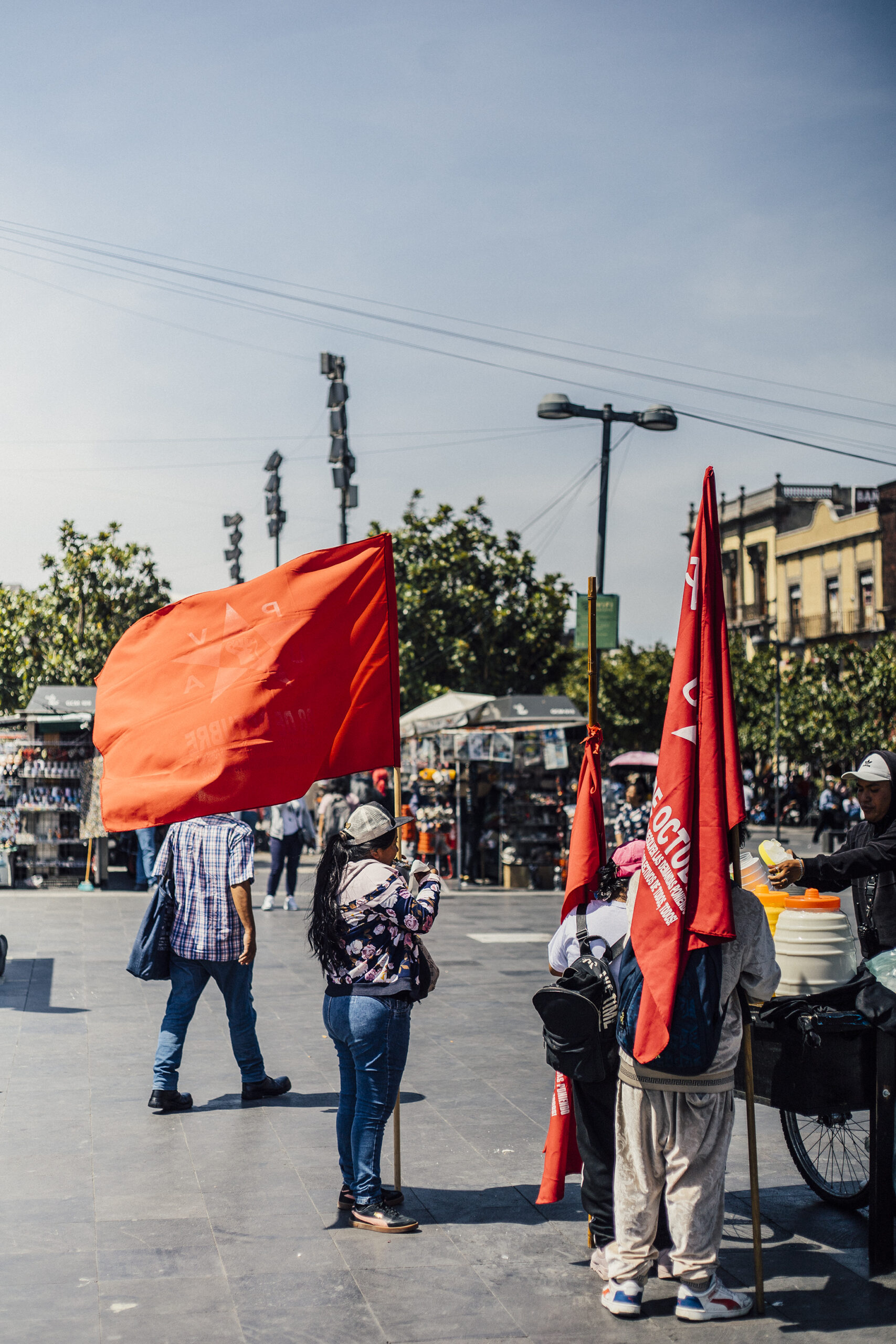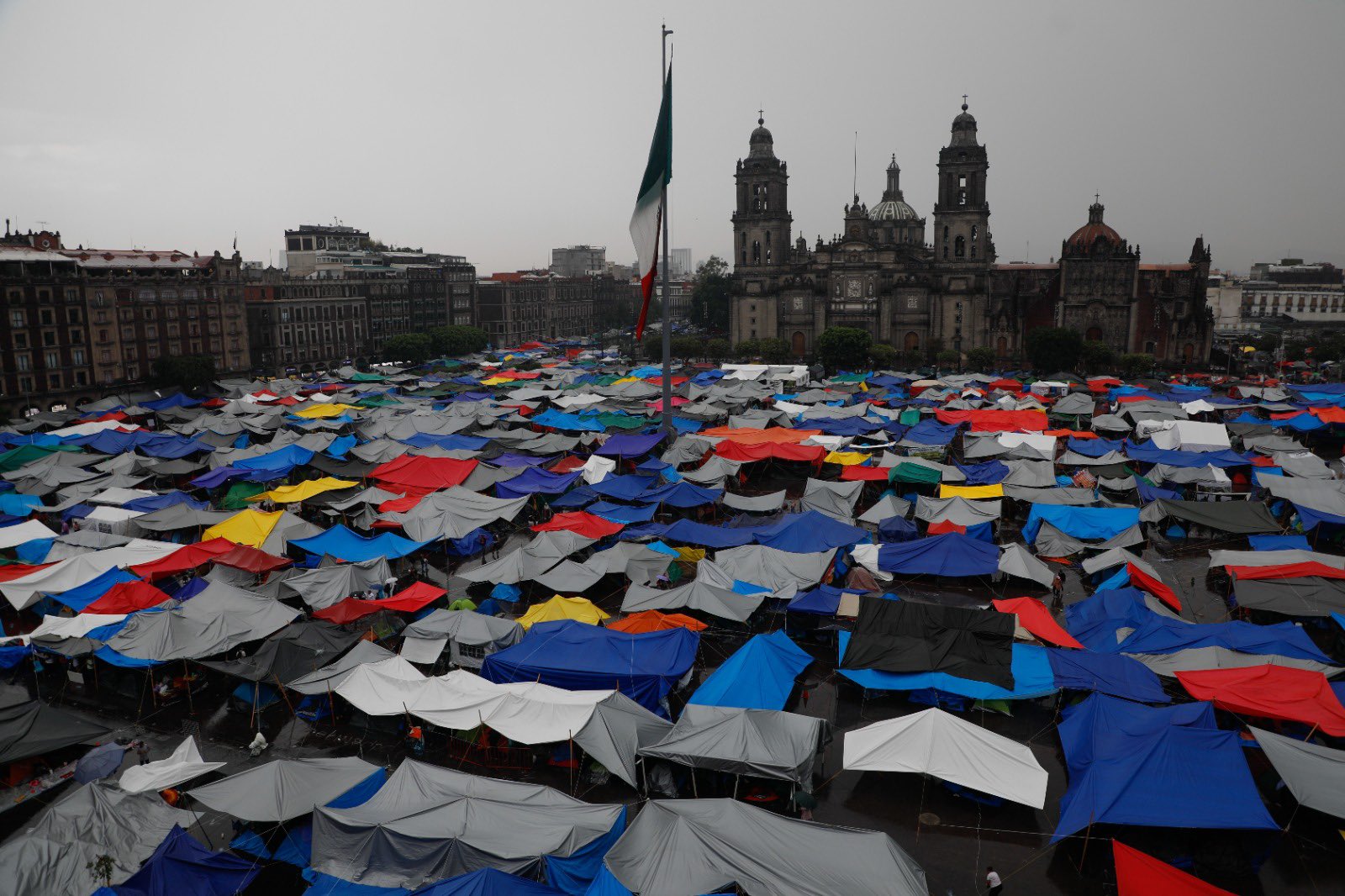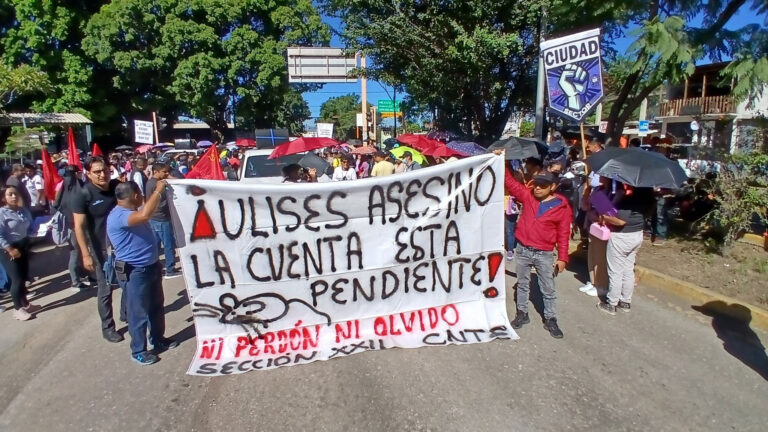MAGISTERIUM PLAINS RESIDENTIAL COMPLEX
This editorial by Luis Hernández Navarro appeared in the May 27, 2025 edition of La Jornada, Mexico’s premier leftist daily newspaper.
What are the CNTE’s Demands?
Immediate repeal of the 2007 ISSSTE Law; restoration of a solidarity-based, collective, and intergenerational pension system; the full recognition of retirement based on years of service (28 for women and 30 for men) instead of the age of 65; the payment of pensions based on the minimum wage rather than on UMAs; the elimination of AFOREs as a privatization model (AFOREs are private companies who manage pensions as individual accounts, extremely restrictive and profitable for finance capital); and a profound restructuring of ISSSTE to restore its social character.
Mexico City. The capital’s Zócalo is a city within a city. Hundreds of tents and plastic roofs of a thousand and one colors, in the already colorful Chilangolandia, sprout like mushrooms throughout the square and surrounding streets. Cardboard floors atop the nylon of makeshift dwellings insulate blankets and sleeping bags from the pavement. At the base of the flagpole, a sign proclaims: “SNTE. Traitor to the Teachers’ Union.” Centimeters below, a poster calls for a united march against the genocide of the Palestinian people.
[Editor’s note: The SNTE is the largest union in Latin America and the main teacher’s union in Mexico. The current head of the SNTE is Alfonso Cepeda Salas, who was previously a member of the neoliberal PRI, but then last year made a Senator by Morena, providing him immunity from pending corruption investigations in Nuevo León. This decision was made by Mario Delgado, now Morena’s Secretary of Education and who previously was involved in implementing the neoliberal education reform the CNTE is fighting against, and that Morena once opposed, when he was in the PRD party.]
Countless hand-lettered signs capture the mood of the moment: “Whoever governs, rights must be defended.” They are accompanied by a multitude of posters of Che Guevara, with the slogan “Until victory, always!” and Emilianos Zapatas, which serve as secular shrines. This is the Llanos del Magisterio Residential Complex, the epicenter of teacher dignity over the past two weeks.
These teachers’ protests aren’t just flash in the pan. They have withstood the most obscene, racist, and mendacious stigmatization campaigns in the media, like the ones they are now suffering.
Despite overcrowding and discomfort, there is an air of camaraderie. The improvised city of resistance was built through collective efforts. Mutual aid guided the improvised architects and workers, who also set up spaces for medical care, meeting rooms, and emergency classrooms to learn the craftsmanship with which demands and slogans are expressed on walls and sidewalks.
At nightfall, at the entrance to the tents, a sea of sandals, sneakers, and boots pile up next to the feet of their owners, who, exhausted from walking through streets and avenues, seek to recharge their batteries inside their tents. Damp towels are hung on the roofs. Coffee is brewed on braziers, and food is cooked for the day. The aromas of stews in pots and pans are in no way inferior to those that envelop the best hotels.
Despite the inclement weather, the seasonal heat wave, and the inclement hail, good spirits prevail. Soaked by the downpour, with the national flag raised behind them, teachers dance and dance. There’s no shortage of laughter, guitars, chess games, plays, poetry recitals, the charity dance by Argelia Guerrero, and concerts by singer-songwriter Amelia Escalante.
Many of the camp’s residents are Indigenous teachers. Women are plentiful. They are one of the movement’s backbones. The conversations in their languages are a kind of symphony of Babel, an indisputable testament to the roots of the National Coordinator of Education Workers (CNTE). Children abound, inventing games and ways to entertain themselves until it’s time for their chores.
At night and in the early morning, the camp is transformed into a huge Soviet.
In assemblies, the day’s tasks are reviewed and the next steps are debated. From time to time, tempers flare. Orators excel. There are plenty of those with the gift of the gab. Among education workers, when it comes to public speaking, “the most toothless chews nails.” Theirs is peaceful civil resistance.

Conferences, roundtables, and debates are part of the daily grind at the residential complex. Just one example. Last Thursday at 7 p.m., amid the day’s political storm, at their camp in front of Monte de Piedad, the Coalition of Indigenous Teachers and Promoters paid tribute to the teacher training college student and anthropologist Juan José Rendón, 20 years after his death. It was a key meeting for understanding the current cycle of CNTE protests.
Rendón wrote The Communal Flower, a central work to understand how, as Benjamín Maldonado explained in his greeting, “the communal way of life of the Mesoamerican peoples is the social basis of their cultural resistance, and communality as the idea that explains it has its fullest meaning in counter-hegemonic social movements, such as the teachers’ movement.”
The key idea of communality sheds a thousand times more light on the fuel that drives these current days of struggle than the string of conspiracy theories of the movement’s neo-detractors, who are in no way envious of what Claudio X. González and Aurelio Nuño have said.
[Ed’s note: González is a right wing opposition figure, recipient of many funds from the US government, who in the past had called the CNTE “terrorists;” Nuño is the former Secretary of Public Education under the neoliberal administration of Enrique Peña Nieto.]

With the specter of the Popular Assembly of the Peoples of Oaxaca looming over them, the protest in the Zócalo, the focal point of the teachers’ protests, brings together at least 30,000 teachers. Not all of them spend the night there. Those who have family and friends in the Mexico Valley stay with them. Early in the morning, they head off to their assigned activities. On weekends, they travel to their places of origin and return to Mexico City on Monday.
The democratic teaching profession has been holding sit-ins and mobilizations for 45 years.

Their protests aren’t just flash in the pan. They come from far away and deep inside. They don’t give up at the first inconvenience. They have withstood the most obscene, racist, and mendacious stigmatization campaigns in the media, like the ones they are now suffering.
In these years, they have achieved nothing without a fight. Their leaders have been assassinated, imprisoned, persecuted, and dismissed.
Yet they persevere. Their efforts, setbacks, and suffering have, over time, turned into victories.
Faced with the prospect of retiring to miserable and unfair pensions, like those offered by the 2007 ISSSTE Law and the UMA, they now fight for a decent pension. They face the enormous power of financial capital and a neoliberal retirement system. They face the Afore (owned by Coppel, Salinas Pliego, and major banks), the true right wing of this country, which the government refuses to touch even with a single tax.
Even if they are insulted and heaped with opprobrium, teachers will not waver in their determination to repeal neoliberal legislation, even if they have to spend the night in Residencial Llanos del Magisterio or march relentlessly across the country.
Luis Hernández Navarro is a writer and journalist, and the Opinion editor of La Jornada newspaper. He participated in the San Andrés talks between the Zapatistas and the government and served as Secretary of the Monitoring and Verification Commission for the Chiapas Peace Accords.
-
CNTE Will Strike, Protest in 2026 so President Sheinbaum Keeps Promise to Repeal Calderón’s ISSSTE Law
The teachers union will mobilize to ensure the Mexican President honours her 2024 campaign promise.
-
CNTE Sets Up Protest Outside Mexico’s Chamber of Deputies
The CNTE teachers’ union leadership pointed out that the federal government “has only offered delaying tactics; its statements are far from the reality experienced by thousands of teachers throughout the country.”
-
CNTE Teachers Thwart Right Wing Party Assembly
Teachers from Valles Centrales disrupted a political event orchestrated for a new party being formed by ex-governor of Oaxaca Ulises Ruiz Ortiz , responsible for repression against teachers in 2006 which led to 20 murders & multiple disappearances.




